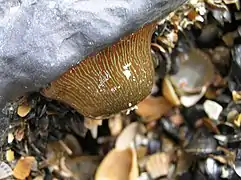Actinia striata
Actinia striata is a species of sea anemone endemic to the Mediterranean Sea.[3]
| Actinia striata | |
|---|---|
 | |
| Scientific classification | |
| Domain: | Eukaryota |
| Kingdom: | Animalia |
| Phylum: | Cnidaria |
| Class: | Hexacorallia |
| Order: | Actiniaria |
| Family: | Actiniidae |
| Genus: | Actinia |
| Species: | A. striata |
| Binomial name | |
| Actinia striata Rizzi, 1907[2] | |
Description
Actinia striata is a solitary sea anemone. The cylindrical column can grow to a height and diameter of 3 cm (1.2 in) and the foot flares out to a diameter of 6 cm (2.4 in). The crown consists of six whorls of tentacles making 196 tentacles in all. The column is variable in colour, smooth and finely striated, reddish, dull green or brown, with darker streaks. The tentacles are reddish or greenish and the oral disc is plain red and somewhat transparent. The tentacles can be fully retracted, and then the sea anemone resembles a striped gelatinous mound.[3]
Distribution and habitat
This species is endemic to the western Mediterranean Sea. Its range includes the Mediterranean coasts of Spain and France, Italy, Greece, Croatia and Morocco.[1] It occurs down to about 30 m (100 ft) and is found attached to rock in both well lit areas and among seaweed and under rocks. It can occur at greater depths than Actinia mediterranea or Actinia equina.[3]
Biology
Like other sea anemones, it is carnivorous, feeding on zooplankton which it catches with its tentacles, which thrust the prey into the mouth. It is a generally uncommon species. The sexes are separate and it is viviparous, with breeding probably taking place in summer.[3]
Status
Actinia striata is found in very shallow water in the Mediterranean Sea and nowhere else. The International Union for Conservation of Nature has assessed its conservation status as being "data deficient" because too little is known about its distribution or population size, and its status. Because of the shallowness of the water in which it lives, it is likely to be affected by the discharge of untreated sewage and deteriorating water quality. However, it is present in several marine protected areas. More research needs to be undertaken to identify the threats that it faces.[1]
References
- Kipson, S.; Garrabou, J.; Ozalp, B.; Linares, C.L.; Ocaña, O.; Bavestrello, G.; Otero Villanueva, M. (2015). "Actinia striata". IUCN Red List of Threatened Species. 2015. Retrieved 4 April 2018.
- WoRMS (2015). "Actinia striata Rizzi, 1907". WoRMS. World Register of Marine Species. Retrieved 4 April 2018.
- "Actinia striata". DORIS. Retrieved 4 April 2018.
External links
- Photos of Actinia striata on Sealife Collection
